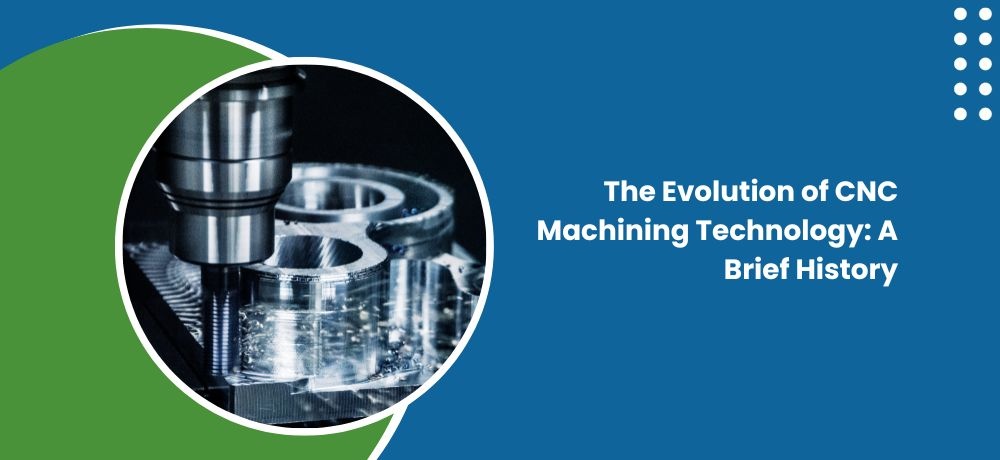The Evolution of CNC Machining Technology: A Brief History

When it comes to the world of manufacturing, few innovations have been as game-changing as CNC machining technology. What was once a laborious and time-consuming process has been transformed by the power of computer-controlled machinery, revolutionizing the way we create everything from precision parts to complex prototypes. But where did this technological marvel come from, and how has it evolved over time?
CNC machining is a critical manufacturing technology that has revolutionized the way parts are made. Over the years, CNC machining technology has evolved significantly, leading to improved precision, speed, and efficiency.
In this blog, we will take a brief look at the history of CNC machining technology. From its early beginnings to the cutting-edge techniques of today, we'll discover how this technology has reshaped the manufacturing landscape and what the future might hold.
1. Early CNC Machines
The earliest machines were developed way back in the 1940s and 1950s. Back then, these machines were massive, cumbersome, and expensive, and were primarily used for military applications. It's crazy to think how far we've come since those early days, isn't it? But despite their limitations, those clunky machines were the beginning of something truly revolutionary - the birth of computer-controlled machinery. From those early military applications, CNC machining technology has gone on to change the face of manufacturing as we know it.
2. Development of CAD/CAM
In the swinging 60s and 70s, the development of computer-aided design (CAD) and computer-aided manufacturing (CAM) software led to a whole new level of CNC machining capability. Suddenly, it was easier than ever before to create complex part geometries, thanks to the power of these software programs. These innovative tools allowed manufacturers to design and manufacture parts with a level of precision and complexity that was previously unimaginable. Think about it - with CAD/CAM software, you could create 3D models of your parts and simulate how they would be machined, all before you even touched a tool. It was like having a crystal ball for machining!
3. Integration of Automation
In the 1980s and 1990s, As the demand for precision and efficiency grew, manufacturers began integrating robotics and other advanced technologies into CNC machines. This resulted in Increased efficiency, reduced costs, and a whole lot of cool factors. Imagine watching a CNC machine whirring away, completely controlled by robotic arms. It was like something out of a sci-fi movie! But it wasn't just about looking cool - automation allowed manufacturers to produce parts at a faster pace and with greater consistency than ever before. And let's not forget about the cost savings. By automating certain processes, manufacturers were able to reduce labor costs and improve their bottom line.
4. Advancements in Precision
As we entered the new millennium, the evolution of CNC machining technology continued at a breakneck pace. With advancements in precision and accuracy, manufacturers were able to produce even more complex parts with greater efficiency than ever before. High-speed machining and 5-axis machining were just a few of the game-changing technologies that emerged during this time. These advancements allowed for faster, more precise cutting and machining, which was particularly useful for parts with complex geometries. And let's not forget about the sheer level of control that these technologies offered. With 5-axis machining, for example, a CNC machine could rotate a part in all three dimensions, allowing for incredibly precise cuts and angles.
5. Integration with Industry 4.0
CNC machining technology has come a long way since its inception in the 1940s and 1950s. Today, it's integrated with cutting-edge Industry 4.0 technologies, including the Internet of Things (IoT), artificial intelligence (AI), and big data. These technologies work together to create a highly efficient and automated manufacturing process that is unlike anything we've seen before. The Internet of Things (IoT) allows CNC machines to communicate with each other and with other systems in the manufacturing plant, providing real-time data and insights that can be used to optimize operations. Artificial intelligence (AI) takes things to the next level, allowing CNC machines to learn and adapt based on the data they collect. This leads to even greater precision and efficiency, as the machines can make adjustments on the fly to ensure that every part is manufactured to the highest standards.
CNC machining technology has come a long way from its early beginnings to the cutting-edge techniques of today. From massive military applications to highly efficient and automated manufacturing processes, CNC machining has reshaped the manufacturing landscape. With the integration of Industry 4.0 technologies, CNC machining is set to continue revolutionizing the way we create everything from precision parts to complex prototypes. Who knows what the future holds? One thing is for sure, the possibilities are endless with CNC machining technology.
If you're looking for CNC machining services in Vancouver BC, reach out to Affinity Manufacturing Ltd. to learn more about our advanced CNC machining capabilities.
To learn more about the services we offer, click here. To learn more about the different industries we cater to, click here. To contact us, click here or call us at (604)591-6667.



